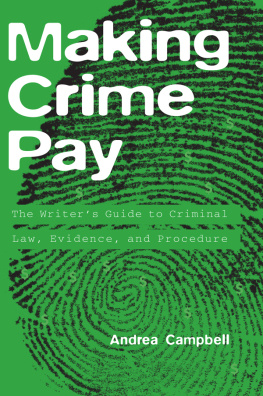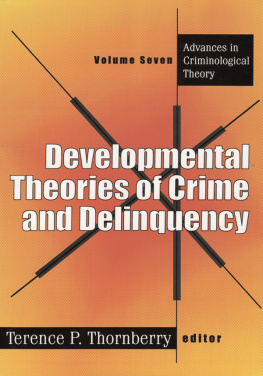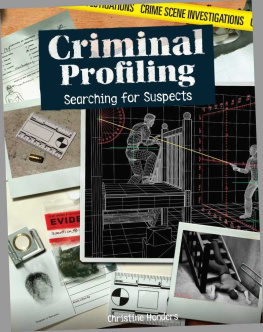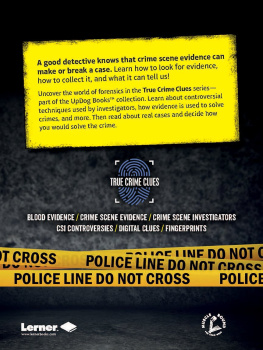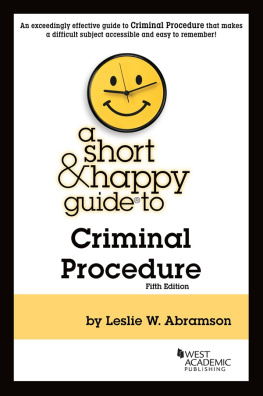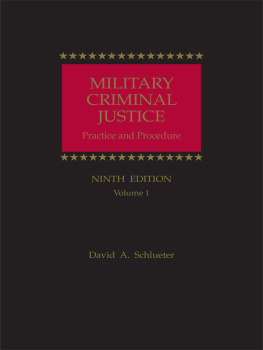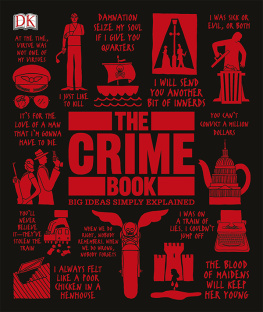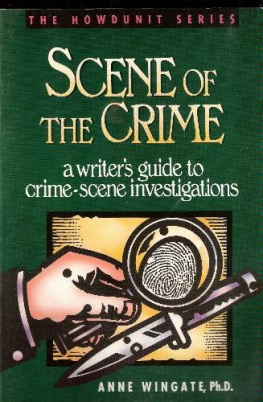Making Crime Pay
The Writers Guide to
Criminal Law, Evidence, and Procedure
By Andrea Campbell

2002 Andrea Campbell
All rights reserved. Copyright under Berne Copyright Convention, Universal Copyright Convention, and Pan-American Copyright Convention. No part of this book may be reproduced, stored in a retrieval system, or transmitted in any form, or by any means, electronic, mechanical, photocopying, recording, or otherwise, without prior permission of the publisher.
06 05 04 03 02 5 4 3 2 1
Published by Allworth Press
An imprint of Allworth Communications
10 East 23rd Street, New York, NY 10010
Cover design by Derek Bacchus, New York, NY
Page composition/typography by CA Brandes
ISBN: 1-58115-216-7
Library of Congress Cataloging-in-Publication Data:
Campbell, Andrea.
Making crime pay: the writers guide to criminal law, evidence, and procedure/by Andrea Campbell.
p.cm.
Includes bibliographical references and index.
ISBN 1-58115-216-7
1. Criminal lawUnited States. 2. Criminal procedureUnited States.
3. Crime writing. 4. authorsHandbooks, manuals, etc. I. Title.
KF9219.8A96.C36 2002
345.73dc21
2001008077
Printed in Canada

Thank you, Michael. Andrea

AUTHORS NOTE: This book is designed to provide information in regard to the subject matter covered. It is not the intent of this book to reprint all the information that is otherwise available to the authors, but to complement, amplify, and encourage reading of other texts.
The purpose of this book is to educate and entertain. It should not be interpreted as legal advice. The author assumes no liability or responsibility to any person or entity with respect to any loss or damage caused or alleged to be caused, directly or indirectly, by the information and illustrations in this book.
In order to keep the law fresh and compelling, Ive used the pronoun he as the subject of most actions and directives within this book. The intent here is not to insinuate that crime and criminal acts are exclusively masculine in nature, but it is more disruptive to the narrative to constantly provide for the equivalence of gender by saying, he or she, throughout the text. If this offends the readers sensibility, I apologize for the distinction.
Preface
The Drama of Crime
No man is above the law and no man is below it; nor do we ask any mans permission when we require him to obey it.
THEODORE ROOSEVELT
N othing can shake up a characters life more than getting himself involved in a crime or certain criminal acts. For sheer human interest, nothing will capture a readers dollars quicker than the peril that inherently comes with the distribution of justicemainly, the law and its procedures. It is complicated, emotional, and often messy. Thats why so many writers use crime and law for storylines. And thats also why so many publishers clamor for the good stuff.
Take a murder, for example: Make it involve a prominent or influential victim, set up a confused crime scene, throw in some mysterious events; then, set it in front of two high-powered attorneys straining at the collar like two pit bulls ready to face off over a bone, and give them a complex venue in which to explore it. For plot points, have the police blunder, let the scientists err, and create a client who is both impulsive and unprepared. Sounds to us like the drama of a crime.
And the great part for the writer is, there are thousands of variations! Provided, of course, they know the detailed ramifications of what life is like, within and without, for all the players. If the writer makes one false move with a statute, applies one incorrect use of jargon, or wends his way into some type of character misrepresentation, his work is sure to wind up as cold and dead as the make-believe victim. The truth is, there are too many experts out there in reader-land. If you try to fudge with the process or dont do your homework and somehow still manage to get publishedit will all come back to haunt youyou will get caught.
The smart writer prepares for the journey ahead of time. Because even though criminal courtroom procedure and strategy varies from state to state, the process is still typical, and with a little extra effort, once you know the basics, it will be easier to fit the process into your own fictional jurisdiction. Making Crime Pay is here to help you do that. We will winnow down the rules so that you can manipulate them with confidence. Whether you want to shake up a characters life with trauma or help to restore it back toward peace, this is a great place to start.
A t a 1987 banquet for the American Academy of Forensic Science members, past president Don Harper Mills astounded the audience with the story of a bizarre death. A medical examiner surveyed the body of Ronald Opus and concluded that he had died from a gunshot wound to the head. The victim had originally jumped from the top of a ten-story building, intending to take his own life. He left a note to that effect, indicating his despondency. But as he fell past the ninth floor, his life was interrupted by a shotgun blast through the window, which killed him instantly.
Neither the shooter nor the deceased was aware that a safety net had been installed just below the eighth floor level to protect building workers. Ronald Opus would have failed to complete his suicide attempt the way he had planned.
Ordinarily, Dr. Mills continued, a person who sets out to commit suicide and ultimately succeeds, even though the mechanism might not be what he intended, is still defined as a suicide. Because Mr. Opus was shot on the way to certain death nine stories below, and because his suicide attempt probably would not have been successful due to the safety net, the medical examiner felt that he had a homicide on his hands.
The shotgun blast had come from a room on the ninth floor that was occupied by an elderly man and his wife. They had been arguing, and he was threatening her with a shotgun. The man was so upset that when he missed his wife, the pellets went out the window, striking Mr. Opus.
When one intends to kill subject A but kills subject B in the attempt, one is still guilty of the murder of B. When confronted with the murder charge, the old man and his wife were adamant. They both said they thought the shotgun was not loaded. The old man said it was his long-standing habit to threaten his wife with the unloaded shotgun. He had no intention to murder her.
Therefore, the killing of Mr. Opus appeared to be an accident; that is, the gun had been accidentally loaded.
The continuing investigation turned up a witness who saw the old couples son loading the shotgun about six weeks prior to the fatal accident. It transpired that the old lady had cut off her sons financial support, and the son, knowing the propensity of his father to use the shotgun threateningly, loaded the gun with the expectation the father would shoot the mother. The case now becomes one of murder on the part of the son for the death of Ronald Opus.
Now comes the bizarre twist. Further investigation revealed that the son in fact was Ronald Opus. He had become increasingly despondent over the failure of his attempt to engineer his mothers murder. This led him to jump off the ten-story building, only to be killed by a shotgun blast passing through the ninth-story window. The son had actually murdered himself, and the medical examiner closed the case as a suicide.
Next page
